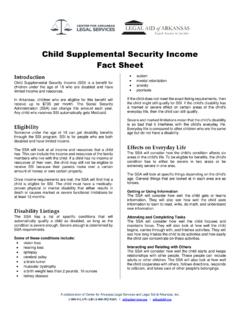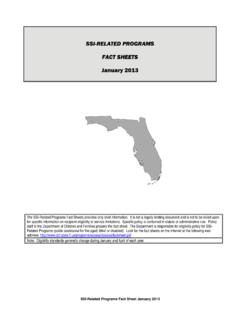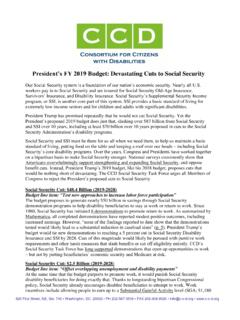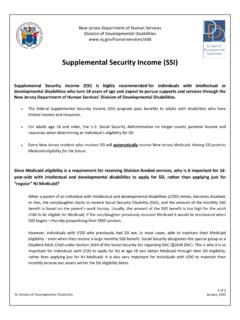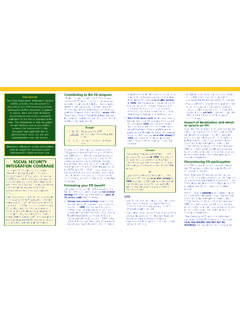Transcription of Social Security: Who's Counting on It? – AARP Fact Sheet
1 1 MARCH 2016 fact SheetSocial security : Who s Counting on It?Alison SheltonAARP Public Policy InstituteSocial security insures families against the loss of income caused by retirement, disability, or Social security is particularly important to Americans ages 65 and over, providing about 88 percent2 of them with a stable source of income for life and keeping nearly 15 million out of poverty. The program, however, faces a long-term financial challenge that could undermine older Americans retirement security . Over the next 75 years, Social security s shortfall the amount by which scheduled payments will exceed revenue ( actuarial deficit ) is projected to be percent of taxable This deficit should be addressed soon.
2 Here are some important facts to remember as the future of Social security is security Insurance Protects All Age GroupsIn 2015, 60 million people, including about 17 million under age 65, received some sort of Social security Social security not only provides retirement income for older Americans but also protects workers of all ages and their families against the risks of death and disability (see figure 1). xxAmong people ages 20 49 who pay Social security taxes, 96 percent have earned survivorship protections for their people ages 21 64 who pay Social security taxes, 90 percent can depend on a monthly cash benefit in the case of a severe and prolonged security Benefits Are Fully Funded for Another 19 YearsThe Social security trust funds had accumulated about $ trillion in reserves at the end of Their value is estimated to peak at $ trillion at the beginning of Later in 2020.
3 The trust funds reserves will begin to be drawn down in order to pay full benefits. According to the Social security trustees, the Social security trust funds reserves will be depleted in 2034. Without any changes, Social security revenue (primarily payroll taxes) still will be enough to pay 79 percent of benefits in 2034 and 73 percent of benefits in is important that reforms necessary to make the program solvent be made sooner rather than later. The sooner action is taken, the less severe x9 About 60 million people receive a Social security security keeps 32 percent of older Americans out of 21 percent of people ages 65 and older live in families that depend on Social security for 90 percent or more of their family 20162the changes to the program must be.
4 For example, either an immediate increase in the payroll tax of percentage points or a percent decrease in all current and future benefits would close the shortfall in the Social security trust funds. Waiting until the point of reserve depletion in 2034, however, will require either a percentage point increase in the payroll tax or a 21 percent reduction in as important, the sooner changes are made, the more time there will be for phasing in the changes, and the more time there will be for future retirees to adjust their retirement plans in the event that benefits are security Is the Principal Source of Family Income for Nearly Half of Older AmericansAmong individuals ages 65 and older.
5 86 percent include Social security benefits as a source of family income, which is almost double the percentage of people who have family income from pensions and retirement savings (see figure 2).11 For most older Americans, Social security is the only retirement income source that is guaranteed for life and adjusted to keep pace with inflation. In contrast, pensions are rarely indexed to inflation, Source: Author s tabulations of Census Bureau, Current Population Survey, March : Pensions and retirement savings include retirement, disability, and survivor pensions from government, military, railroad, union, and private employers.
6 And payments from IRAs, 401(k)s, Keoghs, paid-up insurance policies, and 2 Percentage of Americans Ages 65 or over with Any Family Income from Pensions, Assets, or Social security , by Race and Ethnicity, AmericanAsianHispanicWhitePercentSocial SecurityPensions and retirement savingsAssetsSource: Social security Administration, Beneficiary Data: Number of Social security Recipients at the end of December 2015. Accessed from 1 Who Benefited from Social security in 2015?Disabled workers15%Children7%Spouses 4%Widows, widowers,and parents7%Retired workers67%causing a decline in purchasing power over time, and retirees may outlive their retirement assets.
7 About 21 percent of people ages 65 and older live in families that depend on Social security MARCH 20163benefits for 90 percent or more of their income. Another 24 percent receive at least half but less than 90 percent of their family income from Social security (see table 1).12 Additionally, reliance on Social security as a source of guaranteed income increases with age (see figure 3): about 33 percent of people ages 65 69 depend on Social security for 50 percent or more of their family income, compared with 56 percent of people ages 80 and security benefits are particularly important for women because, on average, women live longer and earn less than men do, so they are more dependent than men are on Social security s progressive benefit and inflation-adjusted, lifetime income.
8 Among women ages 65 and older, 24 percent depend on Social security benefits for 90 percent or more of their family income, compared with 18 percent of security Provides Critical Income Support to MinoritiesAfrican Americans and Hispanics are more likely to earn low or moderate wages. The progressive Social security benefit formula ensures that those lower-wage workers and their families receive a higher benefit relative to their preretirement earnings than do higher-wage minorities are less likely than whites to have family income from pensions and other retirement YEARSHARE OF FAMILY INCOME100%90% than 50%TOTALT housandsPercent (persons)ThousandsPercent (persons)ThousandsPercent (persons)ThousandsPercent (persons)thousandsPercent (persons)20105.
9 Author s tabulations of Census Bureau, Current Population Survey, March 2011 : Includes beneficiaries and nonbeneficiaries ages 65 and over. Family income includes income from all family members, including those in related subfamilies. People with zero or negative family income, negative family earnings, or negative family asset income are excluded. Includes families with no Social security 1 Older Americans Depend on Social security for a Substantial Share of Family Income, 2010 2014 Source: Author s tabulations of Census Bureau, Current Population Survey, March : Includes beneficiaries and nonbeneficiaries ages 65 and older.
10 Family income includes income from all family members, including those in related subfamilies. Includes families with no Social security income. People with zero or negative family income, negative family earnings, or negative family asset income are 3 Reliance on Social security Increases with Age, 6970 7475 7980 andolder100%90% 50% Less than 50% Social security as Share of Family Income (%)MARCH 20164line) rely on Social security for a significant share of their family income. In 2014, about 53 percent of the poor and 62 percent of the near-poor relied on Social security for 90 percent or more of their family income (see figure 6).










